Investigation of the Effectiveness of a New Backfilling Method: “Multi-Arch Pier-Column”
Abstract
:1. Introduction
2. Principles of the Multi-Arch Pier-Column Technique
2.1. Role of Key Stratum
2.2. Technical Process
2.2.1. Judgment of the Top Slab Overburden of Each Hard Rock Layer
2.2.2. Calculation of Breakage Distance for Each Hard Rock Layer
2.3. Technical Principles
3. Evaluation of the Effectiveness of the Multi-Arch Pier-Column Strata Control
3.1. Research Methodology
3.2. Results of Numerical Simulation
4. Design of Goaf Filling Control Engineering
4.1. Drilling Process and Techniques
4.2. Injected Slurry Materials and Their Preparation
5. Multi-Arch Pier-Column Infill Support and Results Analysis
5.1. Shallow Stope Overburden Fracture Zone Detection
5.2. Surface Subsidence Detection
6. Conclusions
Author Contributions
Funding
Informed Consent Statement
Acknowledgments
Conflicts of Interest
References
- Miao, X.X.; Qian, M.G. Research on Green Mining of Coal Resources in China:Current Status and Future Prospects. J. Min. Saf. Eng. 2009, 26, 1–14. [Google Scholar]
- Qian, M.; Jialin, X.U.; Wang, J. Further on the sustainable mining of coal. J. China Coal Soc. 2018, 43, 1–13. [Google Scholar]
- Qian, M.G.; Jia-Lin, X.U.; Miao, X.X. Green Technique in Coal Mining. J. China Univ. Min. Technol. 2003, 32, 344–348. [Google Scholar]
- Xu, J.L.; Xuan, D.Y.; Zhu, W.B.; Wang, X.Z.; Teng, H. Study and application of coal mining with partial backfilling. Meitan Xuebao/J. China Coal Soc. 2015, 40, 1303–1312. [Google Scholar]
- Huang, L.T. Research and development of mining subsidence mechanism. Coal Sci. Technol. 2003, 31, 54–56. [Google Scholar]
- Yan, W.T.; Guo, J.T.; Chen, J.J.; Tan, Y.; Yan, S.G.; Yan, Y.G. Severe Damage Law on the Ground Surface Induced by High-Strength Mining: A Case Study From the Shendong Coal Field in China. Front. Earth Sci. 2022, 10, 10. [Google Scholar] [CrossRef]
- Guo, G.; Wang, Y.; Ma, Z. A New Method for Ground Subsidence Control in Coal Mining. J. China Univ. Min. 2004, 33, 150–153. [Google Scholar]
- Sun, X. Present situation and prospect of green backfill mining in mines. Coal Sci. Technol. 2020, 48, 48–55. [Google Scholar]
- Zhu, X.J.; Zha, F.; Guo, G.L.; Zhang, P.F.; Cheng, H.; Liu, H.; Yang, X.Y. Subsidence Control Design Method and Application to Backfill-Strip Mining Technology. Adv. Civ. Eng. 2021, 2021, 5177174. [Google Scholar] [CrossRef]
- Al Heib, M.M.; Didier, C.; Masrouri, F. Improving Short- and Long-term Stability of Underground Gypsum Mine Using Partial and Total Backfill. Rock Mech. Rock Eng. 2010, 43, 447–461. [Google Scholar] [CrossRef]
- Li, S.; Zhao, Z.M.; Yu, H.X.; Wang, X.M. The Recent Progress China Has Made in the Backfill Mining Method, Part II: The Composition and Typical Examples of Backfill Systems. Minerals 2021, 11, 1362. [Google Scholar] [CrossRef]
- Zhu, W.B.; Xu, J.M.; Xu, J.L.; Chen, D.Y.; Shi, J.X. Pier-column backfill mining technology for controlling surface subsidence. Int. J. Rock Mech. Min. Sci. 2017, 96, 58–65. [Google Scholar] [CrossRef]
- Zhu, W.B.; Yu, S.C.; Xuan, D.Y.; Shan, Z.J.; Xu, J.L. Experimental study on excavating strip coal pillars using caving zone backfill technology. Arab. J. Geosci. 2018, 11, 14. [Google Scholar] [CrossRef]
- Ma, C.; Guo, X.Q.; Zhang, L.Y.; Lu, A.H.; Mao, X.B.; Li, B. Theoretical Analysis on Stress and Deformation of Overburden Key Stratum in Solid Filling Coal Mining Based on the Multilayer Winkler Foundation Beam Model. Geofluids 2021, 2021, 6693888. [Google Scholar] [CrossRef]
- Petlovanyi, M.; Mamaikin, O. Assessment of an expediency of binder material mechanical activation in cemented rockfill. J. Eng. Appl. Sci. 2019, 14, 3492–3503. [Google Scholar]
- Kostecki, T.; Spearing, A.J.S. Influence of backfill on coal pillar strength and floor bearing capacity in weak floor conditions in the Illinois Basin. Int. J. Rock Mech. Min. Sci. 2015, 76, 55–67. [Google Scholar] [CrossRef]
- Bai, J.; Cui, B.; Qi, T.; Zhu, W.; Kang, L. Fundamental theory for rock strata control of key pillar-side backfilling. Meitan Xuebao/J. China Coal Soc. 2021, 46, 424–438. [Google Scholar]
- Deng, K.; Zhang, D.; Zhang, Z. Study on Prediction and Control of Surface Subsidence in Deep Mining. J. China Univ. Min. 2000, 29, 52–55. [Google Scholar]
- Jia-Lin, X.U.; Qian, M.G.; Zhu, W.B. Study on influences of primary key stratum on surface dynamic subsidence. Chin. J. Rock Mech. Eng. 2005, 24, 787–791. [Google Scholar]
- Xu, J.; Zhu, W.; Li, X. Study of the technology of partial-filling to control coal mining subsidence. J. Min. Saf. Eng. 2006, 23, 6–11. [Google Scholar]
- Tang, W.; Sun, X.; Wang, H.; Shi, X.; Xiangyang, L.I.; Yi, L.I.; Mines, S.O. Study on effect of overlying strata stability during strip coal pillar excavation with paste backfilling. Coal Sci. Technol. 2017, 45, 109–115. [Google Scholar]
- Shahsavari, M.; Jafari, M.; Grabinsky, M.l. Influence of Load Path and Effective Stress on One-Dimensional Deformation of Cemented Paste Backfill (CPB) During Deposition and Curing. Geol. Eng. 2022, 40, 2319–2338. [Google Scholar] [CrossRef]
- Miao, X.; Ju, F.; Huang, Y.; Guo, G. New development and prospect ofbackfilling mining theory and technology. Zhongguo Kuangye Daxue Xuebao/J. China Univ. Min. Technol. 2015, 44, 391–399, 429. [Google Scholar]
- Bing-Nan, H. Backfill Mining Technology and Development Tendency in China Coal Mine. Coal Sci. Technol. 2012, 40, 1–5. [Google Scholar]
- Zhiqiang, W.; Xiaofei, G.; Yun, G.; Chaofan, C.; Pengfei, L.I.; Lei, W.; Jingli, Z. Study of grouting technology of overburden-separation to reduce ground subsidence in huafeng coal mine. Yanshilixue Yu Gongcheng Xuebao/Chin. J. Rock Mech. Eng. 2014, 33, 3249–3255. [Google Scholar]
- Li, X.S.; Xu, J.L.; Zhu, W.B.; Wang, X.Z. Theoretical study on the backfill grouting in caving area with strip mining. J. China Coal Soc. 2008, 33, 1205–1210. [Google Scholar]
- Xu, J.; Qian, M. Study on the influence of key strata movement on subsidence. J. China Coal Soc. 2000, 25, 122–126. [Google Scholar]
- Qin, W.; Xu, J.L. Discussion on Key stratum distinguishing method of overlying strata based on the thin slab theory. J. China Coal Soc. 2010, 35, 194–197. [Google Scholar]
- Yao, B.H.; Wang, D.K.; Wang, Y.G.; Wei, J.P. Mechanical mechanism study on the effect of fully-mechanized mining with filling on key strata deformation. Disaster Adv. 2013, 6, 196–203. [Google Scholar]
- Jiang, J.; Zhang, P.; Qin, G.; Fuchen, L.I.; Bin, X.U.; Lina, X.U. Fracture laws of one-side mined high-position hard thick key strata and microseismic energy distribution. J. Min. Saf. Eng. 2015, 32, 523–529. [Google Scholar]
- Jiang, J.Q.; Zhang, P.P.; Qin, G.P.; Xu, B. Analysis of destabilized fracture and microseismic activity of high-located main key strata. Yantu Lixue/Rock Soil Mech. 2015, 36, 3567–3576. [Google Scholar]
- Yu, B.; Zhu, W.; Li, Z.; Gao, R.; Liu, J. Mechanism of the instability of strata structure in far field for super-thick coal seam mining. Meitan Xuebao/J. China Coal Soc. 2018, 43, 2398–2407. [Google Scholar]
- Zhu, W.; Bin, Y.U. Breakage form and its effect on strata behavior of far field key stratum in large space stope. Coal Sci. Technol. 2018, 46, 99–104. [Google Scholar]
- Qian, M.; Miao, X.; Xu, J. Theoretical study of key stratum in ground control. J. China Coal Soc. 1996, 21, 225–230. [Google Scholar]
- Lin, X.J.; Qian, M.G. Method to Distinguish Key Strata in Overburden. J. China Univ. Min. Technol. 2000, 29, 463–467. [Google Scholar] [CrossRef]
- Lin, H.F.; Li, S.G.; Cheng, L.H.; Zhang, W. Key layer distinguishing method of overlying strata based on the thin slab theory. Meitan Xuebao/J. China Coal Soc. 2008, 33, 1081–1085. [Google Scholar]
- Behera, S.K.; Mishra, D.P.; Singh, P.; Mishra, K.; Mandal, S.K.; Ghosh, C.N.; Kumar, R.; Mandal, P.K. Utilization of mill tailings, fly ash and slag as mine paste backfill material: Review and future perspective. Constr. Build. Mater. 2021, 309, 125120. [Google Scholar] [CrossRef]
- Cavusoglu, I.; Yilmaz, E.; Yilmaz, A.O. Additivity effect on properties of cemented coal fly ash backfill containing water-reducing admixtures. Constr. Build. Mater. 2021, 267, 121021. [Google Scholar] [CrossRef]
- Pant, A.; Ramana, G.V.; Datta, M.; Gupta, S.K. Coal combustion residue as structural fill material for reinforced soil structures. J. Clean. Prod. 2019, 232, 417–426. [Google Scholar] [CrossRef]
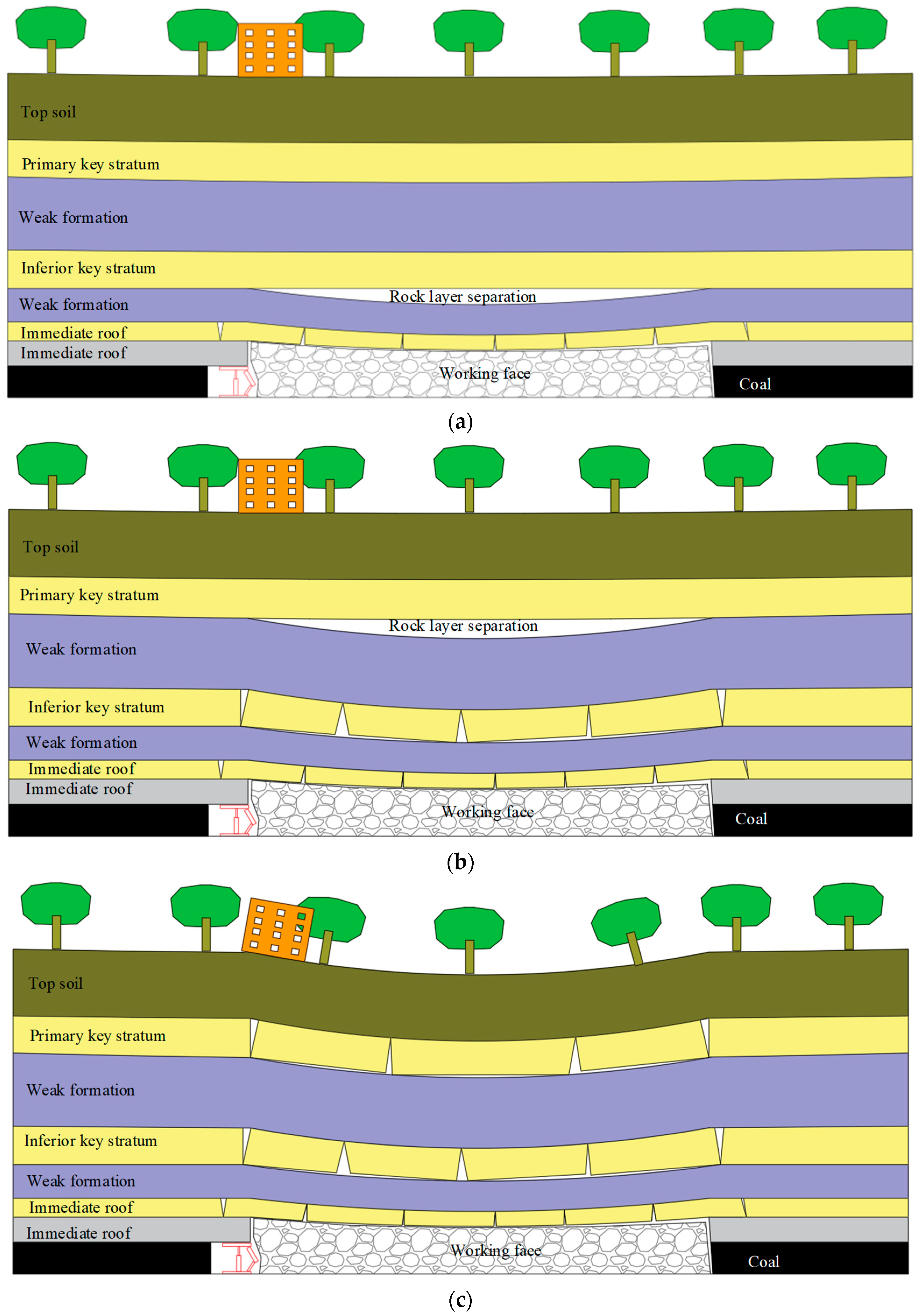

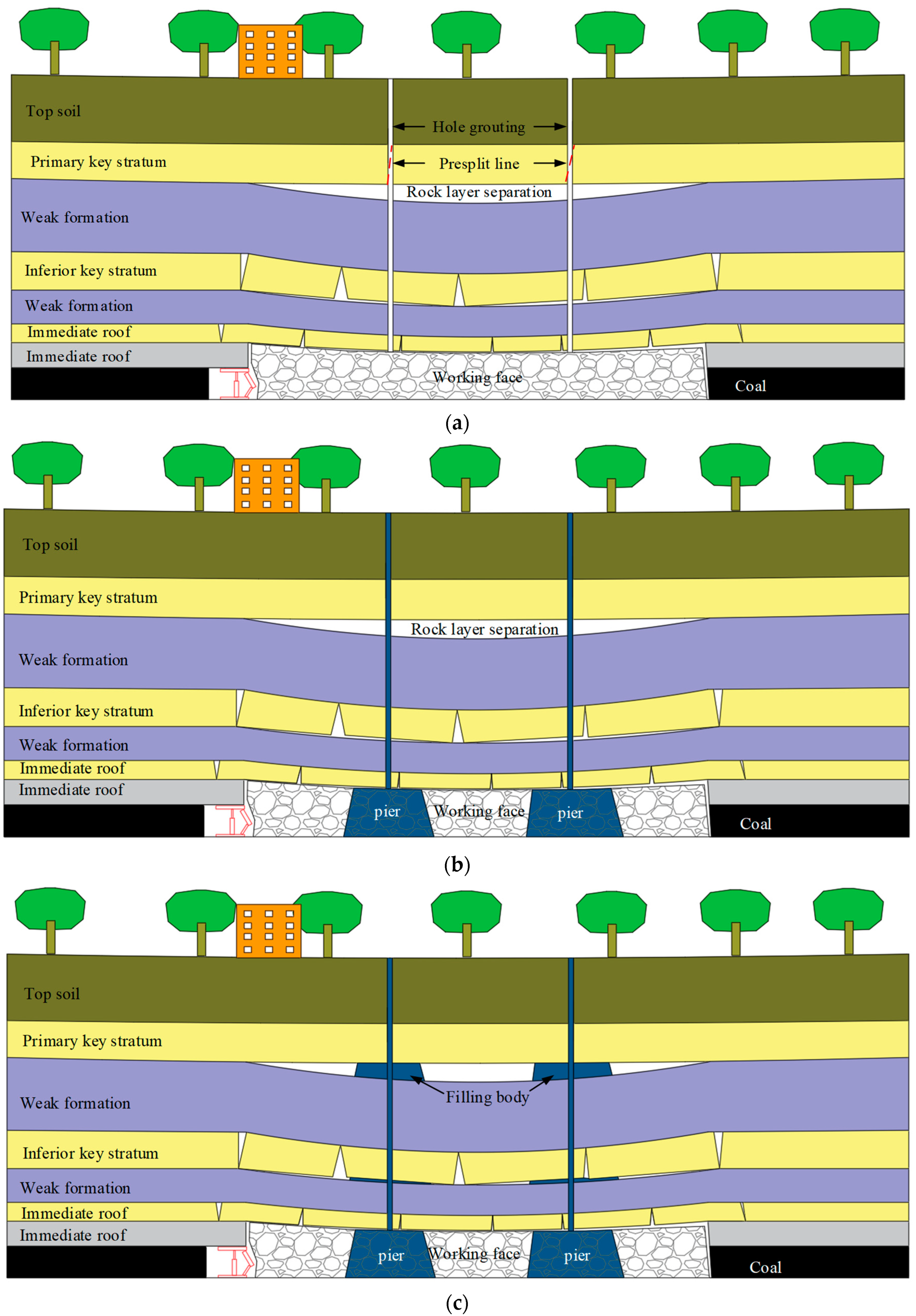


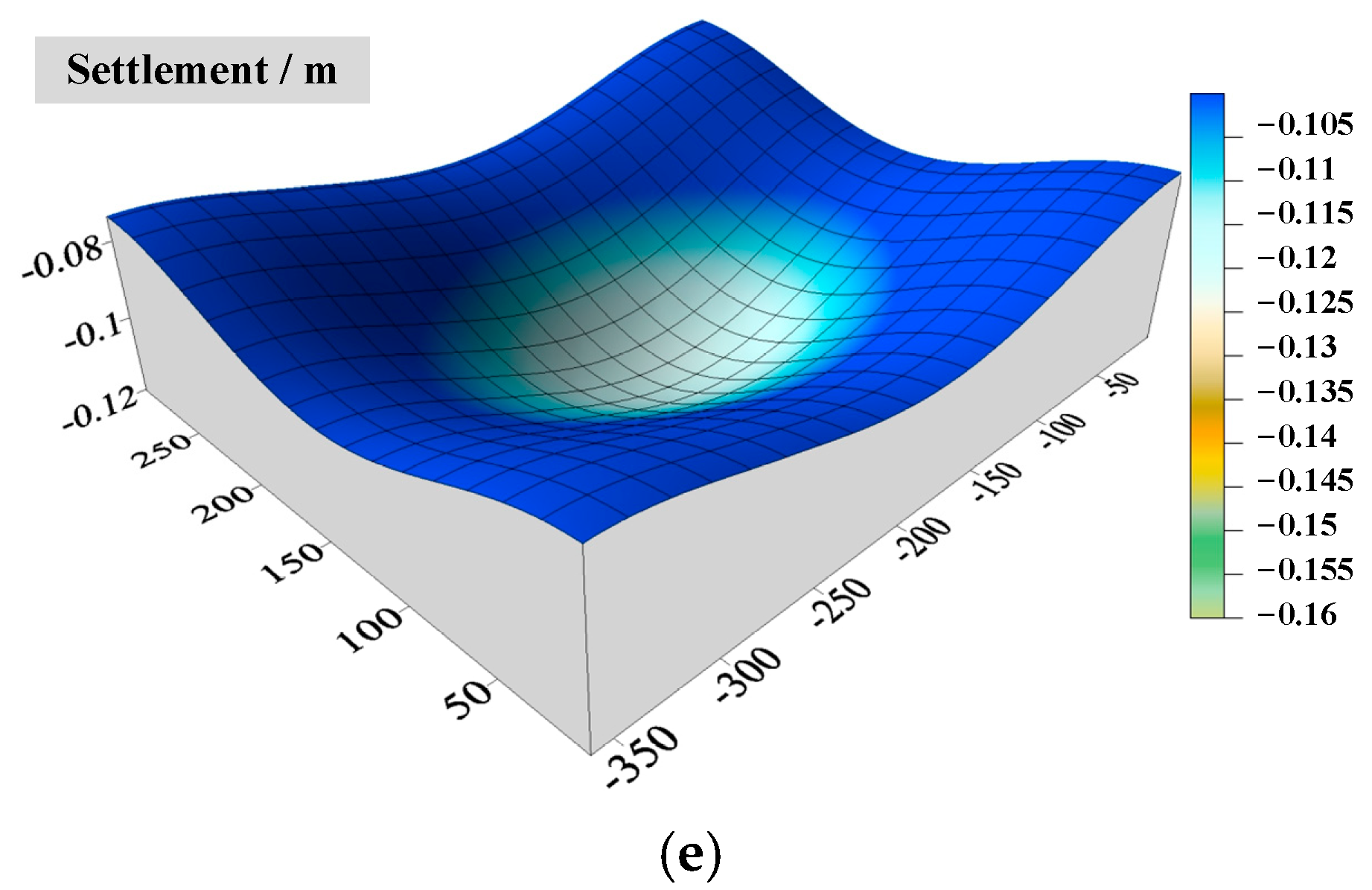

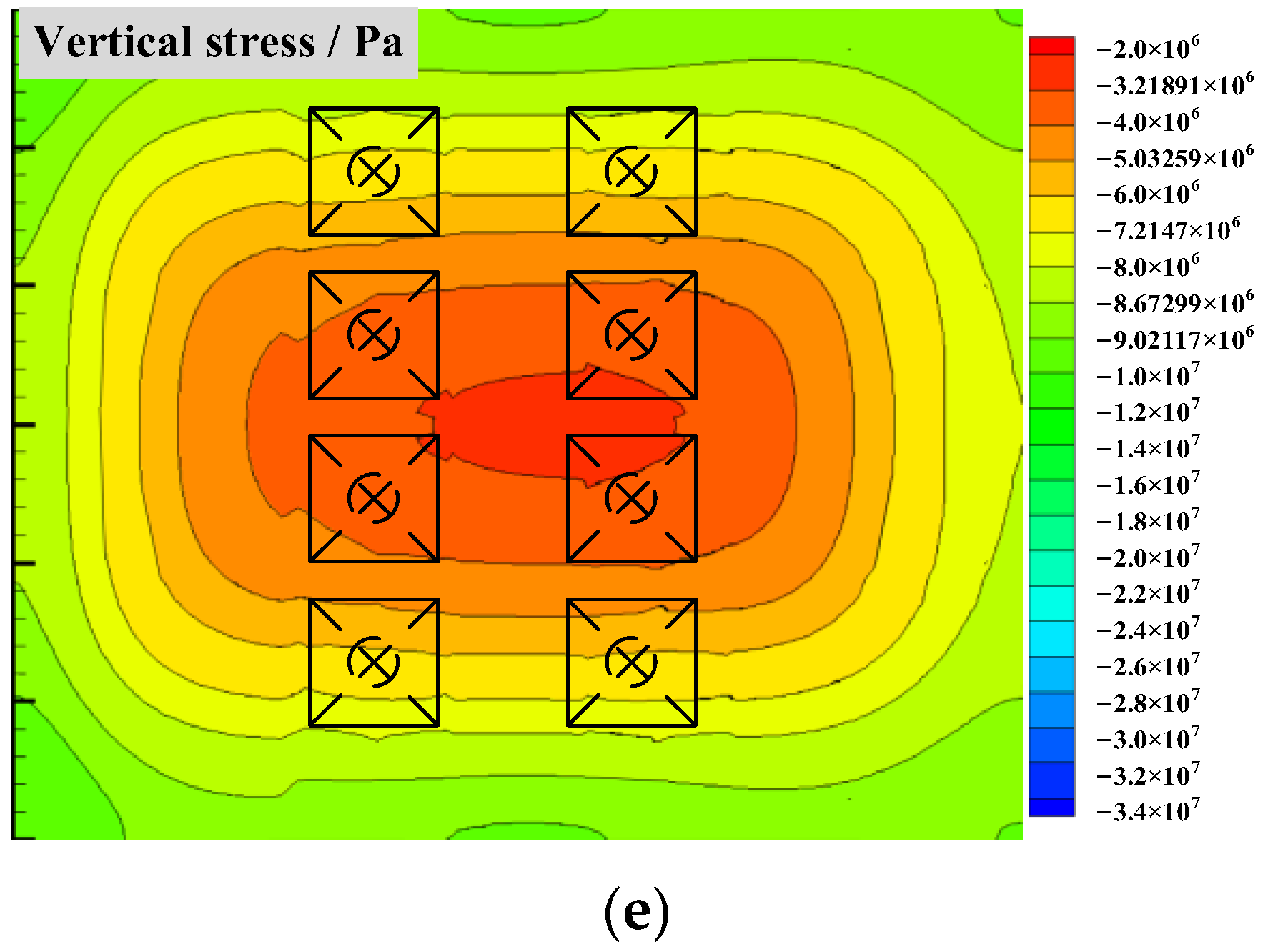
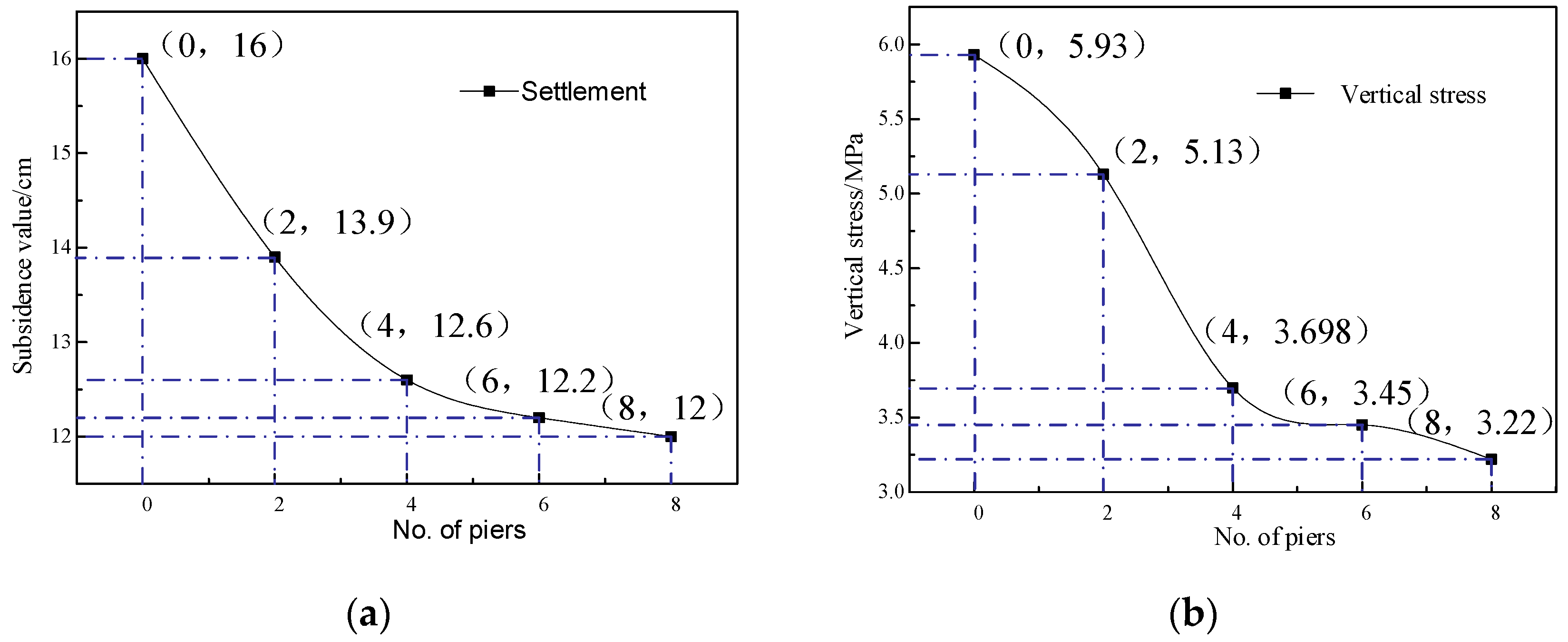
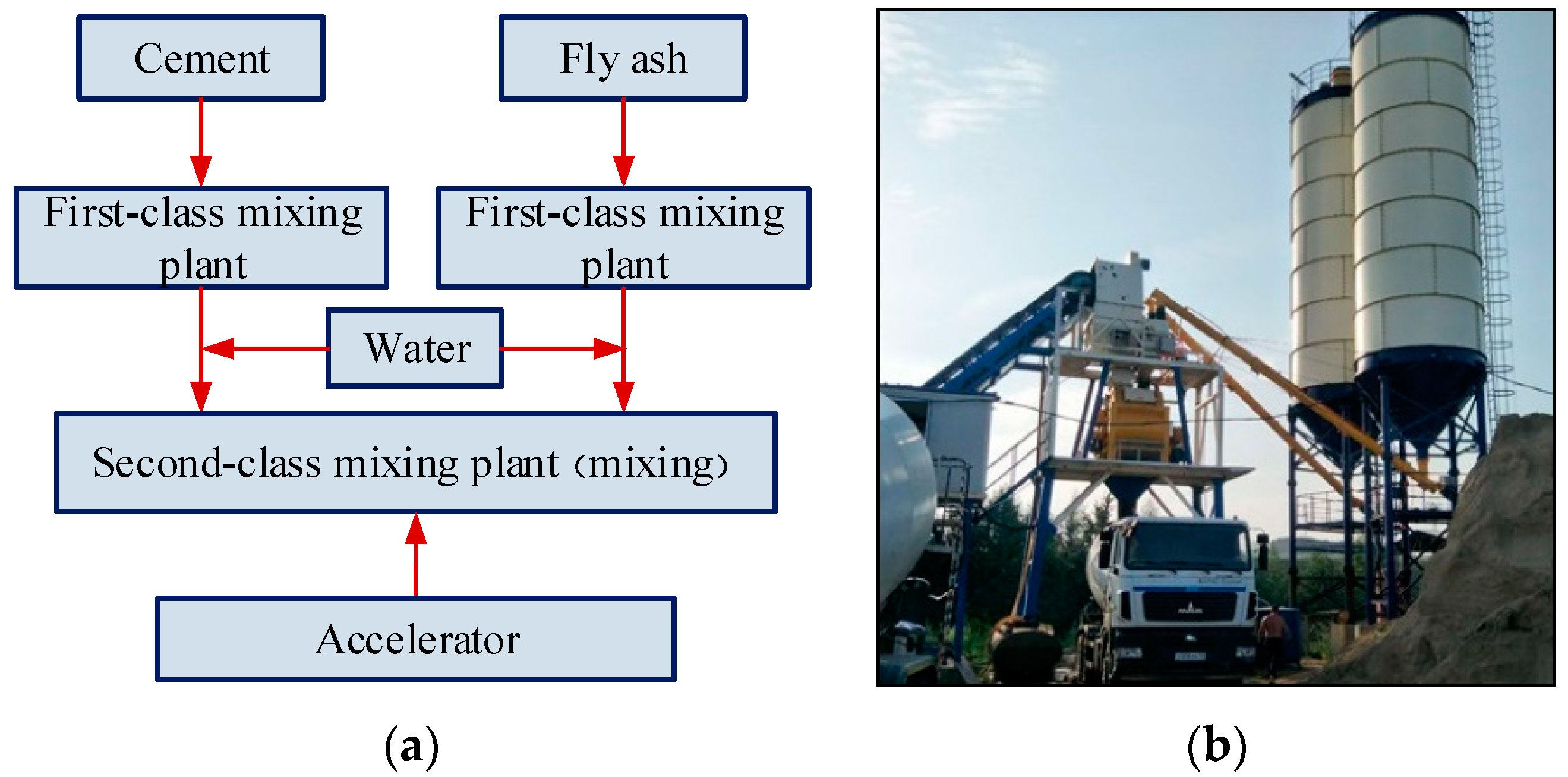
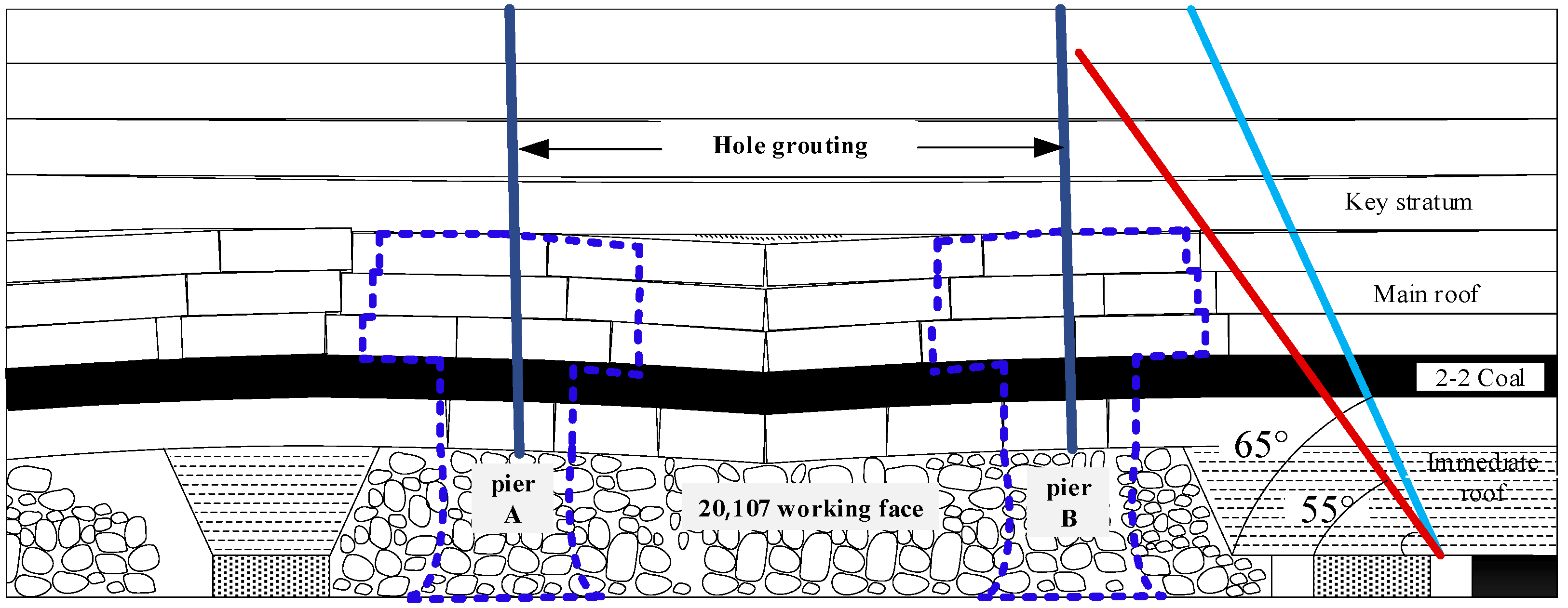
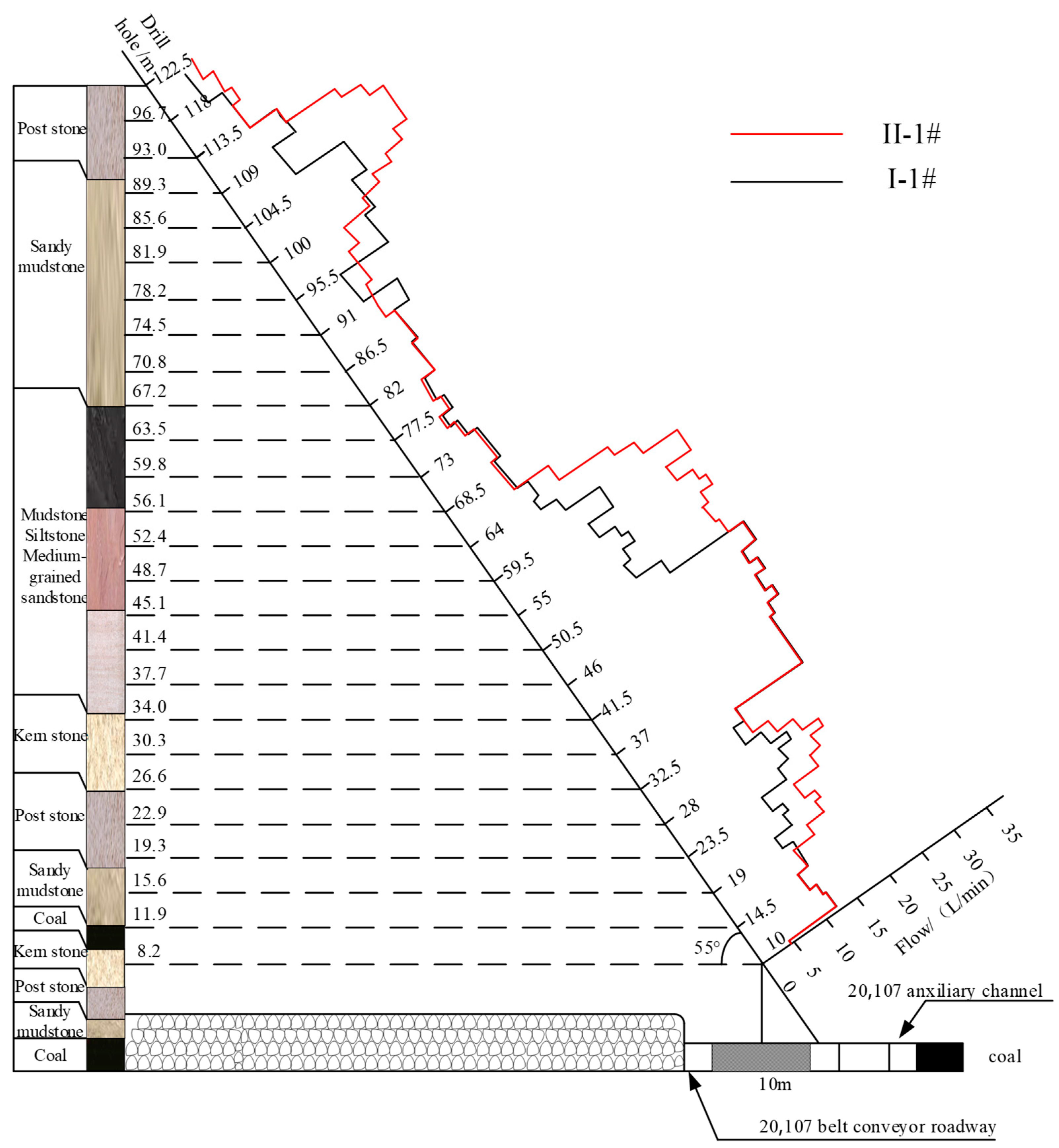


| Rockiness | Height/m | Bulk Modulus/GPa | Shear Modulus/GPa | Internal Friction Angle/° | Internal Cohesion/MPa | Tensile Strength/MPa | Compressive Strength/MPa |
|---|---|---|---|---|---|---|---|
| mudstone | 40 | 6.27 | 6.21 | 26 | 2.80 | 3.77 | 29 |
| conglomerate (geology) | 20 | 16.9 | 12.5 | 31 | 2.20 | 6.4 | 44 |
| sandstone mudstone | 55 | 6.50 | 6.32 | 28 | 3.12 | 4.15 | 23 |
| siltstone | 11 | 15.1 | 10.8 | 32.1 | 3.05 | 6.00 | 42 |
| coal | 4 | 3.58 | 1.45 | 30 | 2.00 | 0.65 | 18 |
| coarse-grained sandstone | 23 | 13.56 | 11.3 | 31 | 8.90 | 7.60 | 40.15 |
| fine-grained sandstone | 65 | 11.80 | 8.20 | 31 | 2.20 | 5.70 | 28.78 |
| backfill | — | 2.50 | 0.54 | 35 | 1.30 | 0.75 | 2.5 |
| Water to Ash Ratio W:C | Cement/bag | Water/kg | Pulping Volume/m3 | Triple B/kg | Salt/kg | Stone Rate/% | Specific Gravity/(g/cm3) |
|---|---|---|---|---|---|---|---|
| 0.6:1 | 22 | 660 | 1.0 | 0.550 | 5.5 | 98 | 1.76 |
| 0.75:1 | 19 | 712 | 1.0 | 0.475 | 4.75 | 97 | 1.62 |
| 1:1 | 15 | 750 | 1.0 | 0.375 | 7.75 | 85 | 1.49 |
| Testing Station | Hole Number | Hole Diameter mm | Azimuth | Location | Azimuth | Hole Depth m |
|---|---|---|---|---|---|---|
| Experimental group | I-1# | 89 | See borehole layout drawing 9 | Filling area | 55° | 122.5 |
| I-2# | 89 | 65° | 113.5 | |||
| Control subjects | II-1# | 89 | See borehole layout drawing 9 | Unfilled areas | 55° | 122.5 |
| II-2# | 89 | 65° | 113.5 |
Publisher’s Note: MDPI stays neutral with regard to jurisdictional claims in published maps and institutional affiliations. |
© 2022 by the authors. Licensee MDPI, Basel, Switzerland. This article is an open access article distributed under the terms and conditions of the Creative Commons Attribution (CC BY) license (https://creativecommons.org/licenses/by/4.0/).
Share and Cite
Xu, G.; Fan, K.; Li, X.; Shi, X.; Ning, J.; Wang, J.; Sun, G.; Chang, J. Investigation of the Effectiveness of a New Backfilling Method: “Multi-Arch Pier-Column”. Energies 2022, 15, 5845. https://doi.org/10.3390/en15165845
Xu G, Fan K, Li X, Shi X, Ning J, Wang J, Sun G, Chang J. Investigation of the Effectiveness of a New Backfilling Method: “Multi-Arch Pier-Column”. Energies. 2022; 15(16):5845. https://doi.org/10.3390/en15165845
Chicago/Turabian StyleXu, Guangzheng, Kegong Fan, Xuehui Li, Xinshuai Shi, Jianguo Ning, Jun Wang, Guoqing Sun, and Jingyu Chang. 2022. "Investigation of the Effectiveness of a New Backfilling Method: “Multi-Arch Pier-Column”" Energies 15, no. 16: 5845. https://doi.org/10.3390/en15165845
APA StyleXu, G., Fan, K., Li, X., Shi, X., Ning, J., Wang, J., Sun, G., & Chang, J. (2022). Investigation of the Effectiveness of a New Backfilling Method: “Multi-Arch Pier-Column”. Energies, 15(16), 5845. https://doi.org/10.3390/en15165845






